英语语音练习题1
英语语音练习题及答案
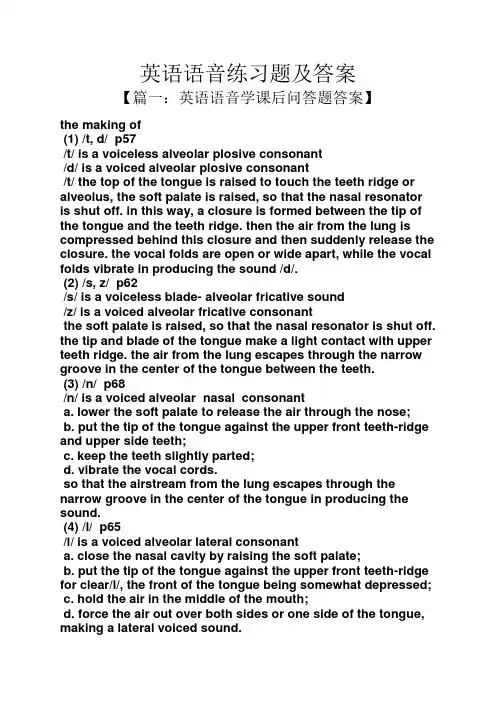
英语语音练习题及答案【篇一:英语语音学课后问答题答案】the making of(1) /t, d/ p57/t/ is a voiceless alveolar plosive consonant/d/ is a voiced alveolar plosive consonant/t/ the top of the tongue is raised to touch the teeth ridge or alveolus, the soft palate is raised, so that the nasal resonator is shut off. in this way, a closure is formed between the tip of the tongue and the teeth ridge. then the air from the lung is compressed behind this closure and then suddenly release the closure. the vocal folds are open or wide apart, while the vocal folds vibrate in producing the sound /d/.(2) /s, z/ p62/s/ is a voiceless blade- alveolar fricative sound/z/ is a voiced alveolar fricative consonantthe soft palate is raised, so that the nasal resonator is shut off. the tip and blade of the tongue make a light contact with upper teeth ridge. the air from the lung escapes through the narrow groove in the center of the tongue between the teeth.(3) /n/ p68/n/ is a voiced alveolar nasal consonanta. lower the soft palate to release the air through the nose;b. put the tip of the tongue against the upper front teeth-ridge and upper side teeth;c. keep the teeth slightly parted;d. vibrate the vocal cords.so that the airstream from the lung escapes through the narrow groove in the center of the tongue in producing the sound.(4) /l/ p65/l/ is a voiced alveolar lateral consonanta. close the nasal cavity by raising the soft palate;b. put the tip of the tongue against the upper front teeth-ridge for clear/l/, the front of the tongue being somewhat depressed;c. hold the air in the middle of the mouth;d. force the air out over both sides or one side of the tongue, making a lateral voiced sound.2. classify the vowels in different ways. p16-17the pure vowels can be classified according to different 4 principles.(2) according to the length of the vowels, they are divided into long vowels and short vowels. the pure vowels in transcription with two dots are long vowels. the diphthongs are also long. the rest are short ones.(3) according to the shape of the lips, the vowels can be divided into rounded vowels and uounded (spread) vowels. the rounded vowels are /?:/ /u:/ /?/ /?/ and the rest are uounded vowels.(4) according to the degree of tenseness of the muscles, the pure vowels are classified asthe eight diphthongs can be classified as closing diphthongs /e?/ /a?/ /??/ /??/ /a?/.and centring diphthongs /??/ /e?/ /??/.3. classify the consonants in different ways. p17-18there are 24 consonants in english. they are classified according to three different principles:1) the vibration of the vocal folds: those with the vibration of the vocal cords are called voiced consonants. those without the vibration of the vocal cords are called voiceless or breathed consonants.2) place of articulation: i.e., where the obstruction of the air passage is formed, the consonants can be distinguished as bilabial, labiodental, dental, alveolar, post-alveolar, palato-alveolar, palatal, velar, and glottal consonants.3) manner of articulation: they can be distinguished as plosives, fricatives, affricates, nasals, laterals, frictionless continuant and semi-vowels.4. how are /i:/ and /i/ produced? what’s the difference between them? p21-22/i:/: the front of the tongue is raised to a height slightly below and behind the front close position; the lips are spread; the tongue is tense; the side rims make a firm contact with the upper molars; it is generally long./i/: the rp vowel /i/ is pronounced with a part of the tongue nearer to the center than to front. it is raised just above the close-mid position; the lips are loosely spread; the tongue is lax; the side rims make a light contact with the upper molars; it is generally short.the difference is not merely the length of sound. there is also a difference in tongue position or quality. for /i:/ the part of the tongue that is highest is the centre of the “front” while for /i/ it is the hinder part of the “front”.5. what are the common features of the front vowels? p26(1) the front of the tongue is raised to various levels in the direction of the hard palate.(2) the tip of the tongue is usually kept down behind the lower teeth.(3) the lips are spread.6. how are the plosives produced? p56plosives are sounds resulting from a blocking or stopping effect on the airstream.6 plosives: /p/,/b/,/t/,/d/,/k/,/g//p/: a voiceless, bilabial plosive consonanta. raise the soft palate so that the nasal cavity is closed;b. breathe in the air and close the lips;c. hold the air behind the closure;d. part the lips open suddenly so that the air comes out of the mouth with a plosive sound;e. do not vibrate the vocal cords. /b/: a voiced bilabial consonantthe organic formation for /b/ is exactly the same as that for /p/ except that the air comes outof the mouth less forcefully and that the vocal cords vibrate./t/: a voiceless alveolar plosive consonanta. raise the soft palate so that the nasal cavity is closed;b. put the tip and blade of the tongue against the upper teeth ridge so that a closure isformed;c. hold the air behind the closure;d. release the closure and blade suddenly so that the air escapes with a plosive sound;e. do not vibrate the vocal folds. /d/: a voiced alveolar plosive consonantthe organic formation for /d/ is the same as that for /t/ except that the air is released less strongly and that the vocal folds vibrate./k/: a voiceless velar plosive consonant.a. raise the soft palate so that the nasal cavity is closed;b. lift the back of the tongue to touch the soft palate so that a closure is formed;c. stop the air stream behind the closure;d. break the closure and the plosive sound is heard;e. be careful not to vibrate the vocal folds./g/: a voiceless velar plosive consonantthe organic formation for /g/ is the same as that for /k/ except that the vocal cords vibrate when the air is released.7. how do you make the affricates /t?/and /d?/? p70/t?/: a voiceless palate-alveolar affricate consonanta. raise the soft palate to stop the air passage and put up the tip of the tongue to touch theback part of the teeth-ridge to form a retracted /t?/ closure;b. the main part of tongue is in position for /?/;c. release the closure slowly, and the air escapes all over the central part of the tongue withfriction;d. the lips are usually somewhat protruded;e. the vocal cords are not made to vibrate./d?/: a voiced palate-alveolar affricate consonantthe affricate /d?/ is formed like /t?/ except that the breath force is weaker and the vocal cords are made to vibrate.8. why are /w/ and /j/ called semi-vowels? p73the semi-vowels have both the features of vowels and consonants.9. please explain “open syllables” and “closed syllables”.p77open syllables are those without any consonant at the end. in british rp only a restricted set of vowels can occur.closed syllables are those that have one or more consonants at the end. all the vowels can appear in these circumstances.10. what is called incomplete plosion? p84when the release stage of a plosive sound is missing or delayed, it is known as incomplete plosion. it takes place in a word when a plosive is followed immediately by another plosive, or a fricative, or an affricate. it may also take place at the junction of words (unless they are separated by a pause).11. when do we have liaison? p86a. consonant (except r) + vowelthe final consonant of the preceding world is united tothe initial vowel of the next word in the same sense group.e.g. give it uphalf an hourb. –r or –re + vowelwhen a word ending with the letter”-r” or “-re” is followed by a wordbeginning with a vowel, the sound /r/ is usually inserted in the pronunciation.e.g. after all far and widec. vowel + vowelwhen a word ending in a vowel is followed by another word beginningwith a vowel, a short/j/ glide is inserted after /i:/, /i/, /ei/, /ai/ and /?i/, or a /w/ glide after /u:/,/u/,/?u/, and/au/e.g. at the endhurry up12. how do you explain assimilation? p95speech sounds seldom occur in isolation. in connected speech, under the influence of their neighbors, are replaced by other sounds. sometimes two neighboring sounds influence each other and are replaced by a new sound which is different from either of the two original sounds. this process is called assimilation.13. how many kinds of stress are there in a word? what are they? p107three principal kinds.(1) primary stress--heavily stressed, usually marked with a vertical stroke() on the upper left hand corner of a syllable carrying the stress, as in be’gin.(2) secondary stress--stressed but subordinate to the primary stress, usually marked with a vertical stroke (?) on the lower left hand corner of a syllable concerned, as in ?contribution.le stress or even stress. double stress can be marked by a high vertical stroke before each of the stressed syllable, as in /?f?f’ti:n/, /b ?:’l?n/, etc.14. how is sentence stress classified? for example. p115-119 three types: sense stress, logical stress, emotional stress.15. please define sense-groups. p140sense-groups are groups of words which are closely connected in meaning and grammar. each sense-group comprises a number of syllables. generally speaking, about six or seven syllables are considered appropriate.16. how many kinetic tones do you know? p153-154the tones which glide from one height to another are called kinetic tone. they are high fall, low fall; high rise, low rise; high fall-rise, and low fall-rise; rise-fall and rise-fall-rise.17. what is a tune? what are the features of the englishtune?p159,164the intonation of the whole tone-group is called a tune.a. normally a low prehead.b. normally a high head.c. in the body, the stressed syllables occupy mostly level pitches and they all fall downgradually in pitch. the unstressed syllables between the stresses ones have about the same height as the stressed syllable preceding them.d. the nucleus is usually at the end of the tune when something is uttered in isolation.e. the changes in the tail are determined by the nucleus. in a fall, the tail remains on a lowlevel pitch[ ]; in a rise or fall-rise, the tail rises gradually[ ]. 18. what’s the function of the falling-rising tune? p173it is used to show contrast, reservation, implication, disagreement, contradiction or warning, etc.1) declarative sentence: the falling-rising tune used in declarative sentences indicates incompleteness and implications, such as concession, gratitude, regret, apology, request, reproach and rebut, etc.2) interrogative sentences:a. special questions: the falling-rising tune used in the special question is stronger than the rising tune. it expresses surprise, interest, request, sympathy, disgust and disbelief, etc.b. general questions: the falling-rising tune used in the general question can express hesitation, request, agitation, exaggeration, etc. no answer is expected by the speaker. c. disjunctive question.3) imperative sentence: the falling-rising tune used in the imperative sentence expresses a warning or an urgent request.4) exclamatory sentence: the falling-rising tune is seldom used in exclamatory sentences. however, when used, it expresses enthusiasm, appreciation, sympathy, encouragement, regret and contempt, etc.【篇二:英语音标练习题—判断发音(含答案)[1]_2】>一、选出划线部分与其他三项发音不同的一项 ( c( a ( d ( b ( b ( a( d( b ( a ( c ( d ( c ( a ( b ( c( a ( d ( b ( a ( a ( b( c ( b ( c ( b ( d ( d ( c ( b( a ( b ( c ( c ( a( a ( b ( d ( d- 1 -- 2 -(((((((((((((((((((((((【篇三:英语语音练习题一】国际音标共48个音素,其中元音音素20个,辅音音素28个。
小学英语语音练习题
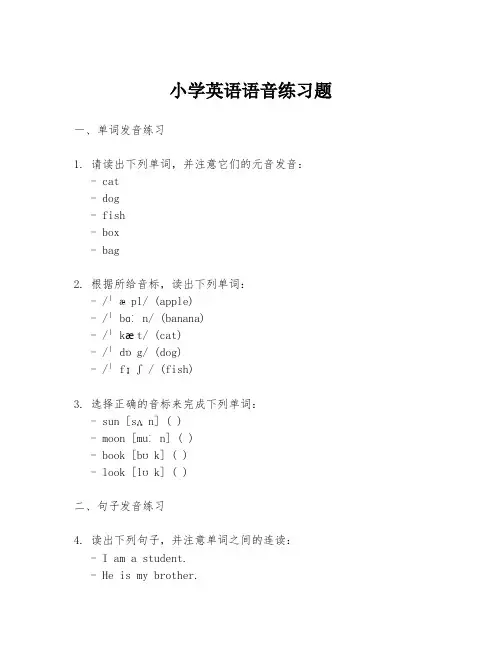
小学英语语音练习题一、单词发音练习1. 请读出下列单词,并注意它们的元音发音:- cat- dog- fish- box- bag2. 根据所给音标,读出下列单词:- /ˈæpl/ (apple)- /ˈbɑːn/ (banana)- /ˈkæt/ (cat)- /ˈdɒg/ (dog)- /ˈfɪʃ/ (fish)3. 选择正确的音标来完成下列单词:- sun [sʌn] ( )- moon [muːn] ( )- book [bʊk] ( )- look [lʊk] ( )二、句子发音练习4. 读出下列句子,并注意单词之间的连读:- I am a student.- He is my brother.- She has a cat.- We like to play football.5. 根据所给音标,读出下列句子:- /ˈhɛlˈloʊ/ Hello, how are you? - /ˈwaʧɪŋ/ I am watching TV.- /ˈdɑːnsɪŋ/ She is dancing.6. 完成下列对话,并注意正确的语音语调: - A: What is your name?B: My name is [ ].- A: Where are you from?B: I am from [ ].三、语音辨析练习7. 听录音,选择发音相同的单词:- A. cat, hat- B. dog, bog- C. fish, wish- D. box, fox8. 听录音,选择正确的句子:- A. I can see a bird.- B. I can see a bed.- C. I can see a bear.9. 听录音,判断下列句子的发音是否正确: - A. The cat is on the mat. ( )- B. The dog is under the rug. ( ) - C. The fish is in the dish. ( )四、语音综合练习10. 根据所给单词,造句并读出:- book- read- like11. 根据所给句子,变换时态并读出:- He is playing basketball. (现在进行时变为一般现在时) - She was reading a book. (过去进行时变为一般过去时)12. 根据所给情景,编写并读出对话:- 情景:在学校图书馆,两个学生在找书。
小学英语语音专项训练题一
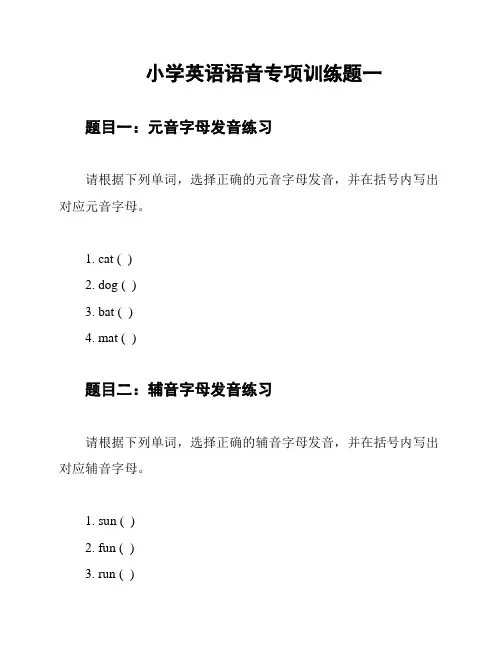
小学英语语音专项训练题一题目一:元音字母发音练习请根据下列单词,选择正确的元音字母发音,并在括号内写出对应元音字母。
1. cat ( )2. dog ( )3. bat ( )4. mat ( )题目二:辅音字母发音练习请根据下列单词,选择正确的辅音字母发音,并在括号内写出对应辅音字母。
1. sun ( )2. fun ( )3. run ( )4. nut ( )题目三:元音字母组合发音练习请根据下列单词,选择正确的元音字母组合发音,并在括号内写出对应元音字母组合。
1. tea ( )2. sea ( )3. eat ( )4. meet ( )题目四:辅音字母组合发音练习请根据下列单词,选择正确的辅音字母组合发音,并在括号内写出对应辅音字母组合。
1. sky ( )2. try ( )3. cry ( )4. fry ( )题目五:语音辨析练习请根据下列单词,选择正确的发音,并在括号内写出对应单词。
1. mouse [maus] ( )2. house [haus] ( )3. ship [ʃip] ( )4. sheep [ʃi:p] ( )5. stop [stɔp] ( )6. stip [stɪp] ( )答案解析以下是每个题目的答案及解析:题目一:元音字母发音练习1. cat (a)2. dog (o)3. bat (a)4. mat (a)解析:这组题目主要考察的是元音字母a的发音。
在cat、bat、mat这三个单词中,元音字母a的发音都是[æ]。
而在dog这个单词中,元音字母o的发音是[ɒ]。
题目二:辅音字母发音练习1. sun (ʌ)2. fun (ʌ)3. run (ʌ)4. nut (ʌ)解析:这组题目主要考察的是辅音字母组合“n”和元音字母“u”的发音。
在这四个单词中,辅音字母组合“n”的发音是[n],而元音字母“u”的发音是[ʌ]。
题目三:元音字母组合发音练习1. tea (iː)2. sea (iː)3. eat (iː)4. meet (iː)解析:这组题目主要考察的是元音字母组合“ee”的发音。
高中英语语音练习题
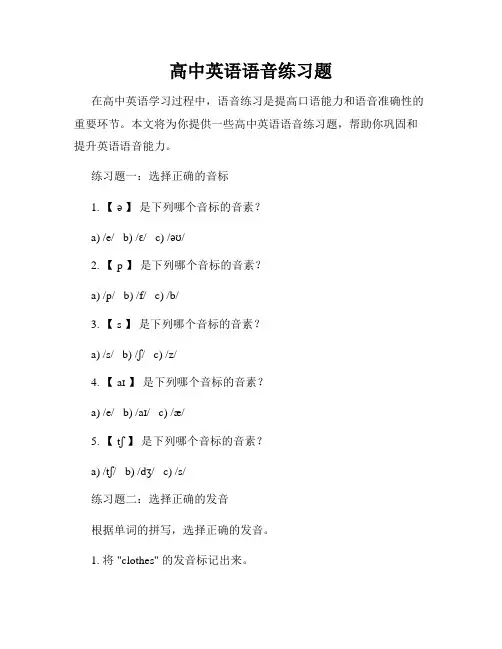
高中英语语音练习题在高中英语学习过程中,语音练习是提高口语能力和语音准确性的重要环节。
本文将为你提供一些高中英语语音练习题,帮助你巩固和提升英语语音能力。
练习题一:选择正确的音标1. 【ə】是下列哪个音标的音素?a) /e/ b) /ɛ/ c) /əʊ/2. 【 p 】是下列哪个音标的音素?a) /p/ b) /f/ c) /b/3. 【 s 】是下列哪个音标的音素?a) /s/ b) /ʃ/ c) /z/4. 【 aɪ】是下列哪个音标的音素?a) /e/ b) /aɪ/ c) /æ/5. 【 tʃ】是下列哪个音标的音素?a) /tʃ/ b) /dʒ/ c) /s/练习题二:选择正确的发音根据单词的拼写,选择正确的发音。
1. 将 "clothes" 的发音标记出来。
a) /kləʊðz/ b) /kləʊz/ c) /kləʊθz/2. 将 "kitchen" 的发音标记出来。
a) /ˈkɪʧən/ b) /ˈkɪtʃən/ c) /ˈkɪsən/3. 将 "photograph" 的发音标记出来。
a) /ˈfəʊtəʊɡrɑːf/ b) /ˈfəʊtəɡræf/ c) /ˈfəʊtəɡræfs/4. 将 "important" 的发音标记出来。
a) /ɪmˈpɔːtənt/ b) /ɪmˈpɔːrtənt/ c) /ɪŋˈpɔːrtənt/5. 将 "height" 的发音标记出来。
a) /haɪt/ b) /heɪt/ c) /hɛɪt/练习题三:音标转写根据下列单词的发音,将其转写为音标。
1. Place ______________________2. Thin _______________________3. Dream ______________________4. Session ____________________5. Beach ______________________练习题四:连读与重音根据对话内容,判断句子中是否存在连读或需要特别注意重读的单词。
英语语音练习题及答案
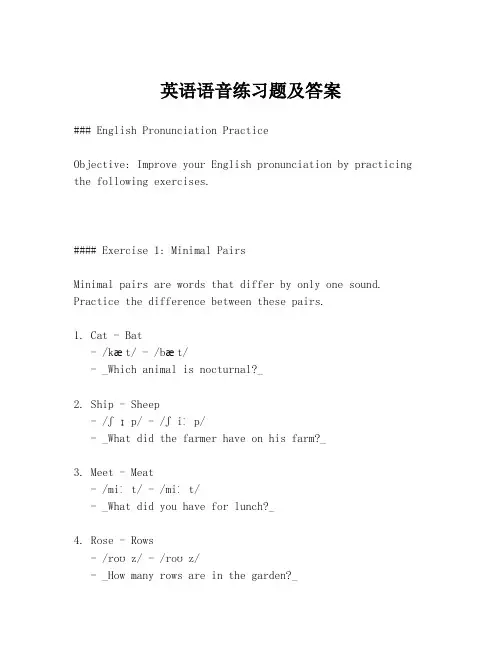
英语语音练习题及答案### English Pronunciation PracticeObjective: Improve your English pronunciation by practicing the following exercises.#### Exercise 1: Minimal PairsMinimal pairs are words that differ by only one sound. Practice the difference between these pairs.1. Cat - Bat- /kæt/ - /bæt/- _Which animal is nocturnal?_2. Ship - Sheep- /ʃɪp/ - /ʃiːp/- _What did the farmer have on his farm?_3. Meet - Meat- /miːt/ - /miːt/- _What did you have for lunch?_4. Rose - Rows- /roʊz/ - /roʊz/- _How many rows are in the garden?_5. Bread - Bred- /brɛd/ - /brɛd/- _Did you bake the bread or were you bred in this city?_#### Exercise 2: Word StressCorrect stress placement is crucial for clear communication. Practice these words.1. Record- /ˈrɛkərd/ (noun) /rɪˈkɔrd/ (verb)- _I want to record this moment._2. Present- /ˈprɛzənt/ (noun) /prɪˈzɛnt/ (verb)- _She gave a present to her friend._3. Object- /ˈɑbdʒɛkt/ (noun) /əbˈʤɛkt/ (verb)- _The artist created a beautiful object._4. Subject- /ˈsʌbdʒɛkt/ (noun) /səbˈʤɛkt/ (verb)- _The subject of the book is fascinating._5. Contrast- /ˈkɑntræst/ (noun) /kənˈtræst/ (verb)- _The colors provide a nice contrast._#### Exercise 3: Consonant ClustersConsonant clusters can be challenging. Practice these words to improve your pronunciation.1. Sprint- /sprɪnt/- _The athlete did a sprint to the finish line._2. Strength- /strɛŋθ/- _She showed great strength in lifting the weight._3. Squirrel- /ˈskwɜːrəl/- _The squirrel was gathering nuts for winter._4. Structure- /ˈstrʌktʃər/- _The structure of the building is impressive._5. Scramble- /ˈskræmbəl/- _The soldiers had to scramble to safety._#### Exercise 4: Vowel SoundsVowels are the core of pronunciation. Practice these vowel sounds.1. Bite - Byte- /baɪt/ - /baɪt/- _Did you take a bite of the apple or save a byte on the computer?_2. Sheep - Ship- /ʃiːp/ - /ʃɪp/- _The sheep was on the ship heading to a new pasture._3. Boot - Food- /buːt/ - /fuːd/- _Put on your boots and let's go get some food._4. Meet - Mate- /miːt/ - /meɪt/- _Let's meet at the dock, my mate is waiting there._5. Goat - Goad- /ɡoʊt/ - /ɡoʊd/- _The farmer used a goad to lead the goat._#### Answers:1. Exercise 1: Nocturnal animals include bats. The farmer had sheep. You had meat for lunch. There are many rows in thegarden. You were bred in this city if you were born there.2. Exercise 2: "Record" as a noun is pronounced /ˈrɛkərd/, and as a verb, it's /rɪˈkɔrd/. "Present" as a noun is/ˈprɛzənt/, and as a verb, it's /prɪˈzɛnt/. "Object" as a noun is /ˈɑbdʒɛkt/, and as。
七年级上册英语语音专题训练(一)(含答案)
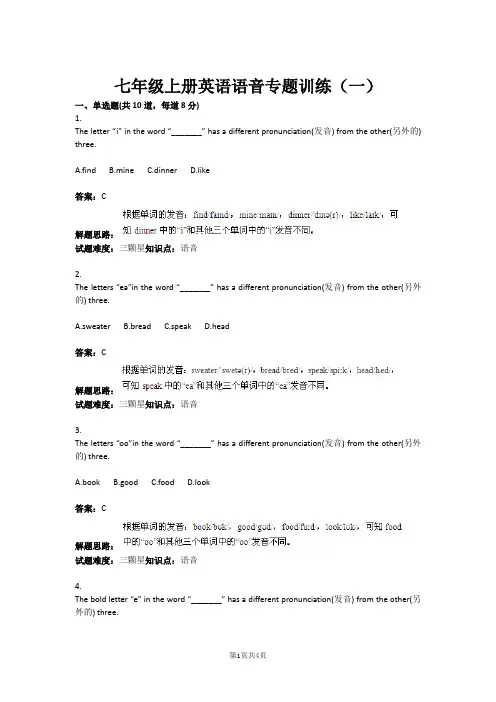
七年级上册英语语音专题训练(一)一、单选题(共10道,每道8分)1.The letter “i” in the word “_______” has a different pronunciation(发音) from the other(另外的) three.A.findB.mineC.dinnerD.like答案:C解题思路:试题难度:三颗星知识点:语音2.The letters “ea”in the word “_______” has a dif ferent pronunciation(发音) from the other(另外的) three.A.sweaterB.breadC.speakD.head答案:C解题思路:试题难度:三颗星知识点:语音3.The letters “oo”in the word “_______” has a different pronunciation(发音) from the other(另外的) three.A.bookB.goodC.foodD.look答案:C解题思路:试题难度:三颗星知识点:语音4.The bold letter “e” in the word “_______” has a different pronunciation(发音) from the other(另外的) three.A.sheB.meC.theseD.help答案:D解题思路:试题难度:三颗星知识点:语音5.The letters “th” in the word “_______” has a dif ferent pronunciation(发音) from the other(另外的) three.A.thankB.thingC.mathD.that答案:D解题思路:试题难度:三颗星知识点:语音6.The letter “s” in the word “_______” has a different pronunciation(发音) from the other(另外的) three.A.hisB.booksC.awlaysD.yours答案:B解题思路:试题难度:三颗星知识点:语音7.Which word doesn’t have the pronunciation(发音) /k/ in the following options(下面的选项)?A.canB.backC.sixD.know答案:D解题思路:试题难度:三颗星知识点:语音8.Which word has the pronunciation(发音) /e/ in the following options(下面的选项)?A.sellB.mapC.fatD.black答案:A解题思路:试题难度:三颗星知识点:语音9.Which word doesn’t have the pronunciation(发音) /aʊ/ in the following options(下面的选项)?A.howB.brownC.aboutD.sport答案:D解题思路:试题难度:三颗星知识点:语音10.The phonetic transcription(音标) for the word “breakfast” is ________.A. B. C. D.答案:C解题思路:试题难度:三颗星知识点:语音二、填空题(共2道,每道11分)11.英语有____个英文字母,其中元音字母依次为____ ____ ____ ____ ____,其余为辅音字母;____是英语语音中不可再分割的最小单位,英语音素分为元音音素和辅音音素,元音音素分为单元音和____元音,例如/aʊ/ 是个____元音,辅音音素中发音时声带不振动的叫____,发音时声带振动的叫____。
英语语音试题及答案
英语语音试题及答案一、听力理解(共20分)1. 听录音,选择你所听到的单词或短语。
A) apple B) banana C) cherry D) date录音内容:[apple]答案:A2. 听对话,选择正确的答案。
录音内容:What time is it now?A) It's 8 o'clock. B) It's 9 o'clock. C) It's 10 o'clock.D) It's 11 o'clock.答案:B二、语音辨析(共20分)1. 下列单词中,发音不同的单词是哪一个?A) cat B) hat C) mat D) rat答案:D2. 根据发音,选择正确的单词组合。
A) ship - sheep B) meet - meat C) fish - wish D) dog -fog答案:C三、连读与失去爆破(共20分)1. 听录音,判断下列句子中哪些单词发生了连读或失去爆破。
录音内容:I have a good idea.A) have a B) good idea C) have a good D) a good答案:A2. 根据语音规则,下列句子中哪些单词的发音需要连读或失去爆破?句子:Can you help me with my homework?A) can you B) you help C) help me D) with my答案:A, C四、重音与语调(共20分)1. 听录音,选择正确的重音位置。
录音内容:I'm going to the market.A) I'm B) going C) to the D) market答案:C2. 根据语境,下列句子应该使用什么语调?句子:Is this your book?A) 升调 B) 降调 C) 平调 D) 疑问升调答案:D五、综合语音理解(共20分)1. 听短文,回答问题。
英语语音练习题及答案
英语语音练习题及答案一、音标辨析1. 请根据音标读出下列单词:- /ˈæpəl/ ______- /ˈdɒg/ ______- /ˈkæn.də/ ______- /ˈkæp.tʃə/ ______- /ˈbɪz.ni:s/ ______- /ˈtʃɛr.iz/ ______答案:Apple, Dog, Canada, Captain, Business, Cherries2. 请根据音标判断下列单词的发音是否相同:- /ˈkɒ f.i/ 和 /ˈkɒ f.ɪ/()- /ˈæp.əl/ 和 /ˈæp.ɪl/()答案:不同,不同二、连读练习3. 请将下列句子中的单词进行连读,并读出正确的发音:- I am a student. (I am a student.)- How do you do? (How do you do?)- Can you help me? (Can you help me?)- What time is it? (What time is it?)三、重音练习4. 请读出下列单词的重音位置:- camera /ˈkæm.ər.ə/- family /ˈfæm.ɪ.li/- banana /bəˈnɑː.nə/- computer /kəmˈpjuː.tər/5. 请根据重音位置读出下列短语:- a family man- a camera shot- a banana peel- a computer science四、节奏和语调练习6. 请根据句子的语调读出下列句子:- She is very beautiful. (升调)- He is not coming. (降调)- Can you believe it? (疑问升调)- I don't know what to do. (陈述降调)7. 请根据句子的节奏读出下列对话:- A: Where are you going? (Where are you going?)B: I'm going to the library. (I'm going to the library.)五、综合练习8. 请根据所给音标读出下列句子,并注意连读、重音和语调:- /ˈhɛl.loʊˌhɔw ˈæz.ju/ (Hello, how are you?)- /ˈmaɪˌnæm ɪz ˈmiː.kəl/ (My name is Michael.) - /ˈdʒɛn.ər.əl ˌɪnˈfɔːr.mə.tʃən ɪzˈɪm.pɔː.tənt/ (General information is important.)9. 请根据所给音标读出下列对话,并注意连读、重音和语调:- A: /ˈwɪl.ju ˈhæv əˈpɑː.ti/ (Will you have a party?)B: /ˌjɛs ˈɪ d.oʊ/ (Yes, I do.)请注意,以上练习题旨在帮助学习者提高英语语音的准确性和自然性。
英语语音练习题及答案
英语语音练习题及答案一、语音匹配题:(每题2分,共20分)1. 根据所给音标,选择正确的单词。
- [ɪ] a) ship b) sheep c) sheeps- [ɑ:] a) car b) heart c) cart- [eɪ] a) gate b) eight c) ate- [æ] a) cat b) bat c) pat- [ɔ:] a) for b) four c) door2. 选择与给定音标相匹配的单词。
- [ʌ] a) book b) foot c) put- [ɪə] a) here b) hear c) hair- [u:] a) shoe b) school c) food- [ɔɪ] a) toy b) boy c) point- [əʊ] a) home b) hope c) boat答案:1. b a b a b2. c a b c b二、连读练习题:(每题2分,共20分)3. 根据所给句子,找出正确的连读形式。
- I am [æm] going to [gəʊɪŋ] the [ðə] store.- She has [hæz] a lot [lɒt] of [əv] experience.4. 完成下列句子的连读部分。
- I'll [aɪl] be there [ðeə] soon.- Don't [dəʊnt] forget [fərget] to [tuː] call [kɔːl]me.答案:3. am going, has a lot4. I'll be, Don't forget to三、重音练习题:(每题2分,共20分)5. 选择句子中单词的正确重音位置。
- I'm [aɪm] not [nɒt] going [ˈgəʊɪŋ].- He's [hiːz] been [biːn] there [ðeə].6. 根据句子,标出正确的重音。
初一英语语音练习题
初一英语语音练习题一、单词发音练习1. 请根据音标读出下列单词:- [ˈkæt] [ˈhɑːsˌbænd] [ˈdɔːg] [ˈbiːtʃ] - [ˈmɪsɪz] [ˈsʌn] [ˈpiːpəl] [ˈtɛʃər]2. 请将下列单词按照音标正确排序:- [ˈkɪtən] [ˈlɪbəri] [ˈtɛmpl] [ˈʃɔːp]二、句子发音练习1. 请正确读出以下句子,并注意连读和失去爆破:- "Hello, how are you?"- "I am a student."- "The cat is on the mat."2. 请根据音标读出下列句子:- [ˈhɛlθɪ] [ˈkæt] [ˈɪz] [ɒn] [ðə] [ˈmæt]- [aɪ] [æm] [ə] [ˈstjuːdənt]三、对话发音练习1. 请将下列对话中的每个句子正确读出,并注意语调:- A: What's your name?B: My name is Tom.- A: Where are you from?B: I'm from China.2. 请根据音标读出下列对话:- A: [wɒts] [jɔːr] [neɪm]?B: [maɪ] [neɪm] [ɪz] [tɒm]- A: [wɛr] [jɔː] [frɒm]?B: [aɪm] [frɒm] [ˈtʃaɪnə]四、语音规则练习1. 请根据语音规则读出下列单词,并注意重音:- [ˈʌndəstændɪŋ] [ˈɪmpɔːtənt] [ˈprɒspɛktɪv]2. 请将下列单词按照重音位置正确排序:- [ˈɪntrəstɪd] [ˈɪntrəstɪŋ] [ˈɪntrəst]五、语音综合练习1. 请根据所给音标,读出下列句子,并注意语调、连读和失去爆破:- [aɪ] [wɒnt] [tuː] [ˈɡɪv] [jɔː] [ˈɛsɪstəns]- [ðə] [ˈwɜːld] [ɪz] [ə] [ˈwʌndərfʊl] [ˈpleɪs]2. 请根据所给音标,读出下列对话,并注意对话中的语调变化:- A: [aɪ] [ˈdɪdnt] [ˈsiː] [jɔː] [ˈɛstərdeɪ]B: [ɪts] [ˈɔːlˈrɪt] [aɪ] [ˈdɪdnt] [ˈsiː][jɔː]六、语音自我检测1. 请自己准备一些初一英语单词和句子,然后录音,之后自己听录音,检查发音是否准确。
- 1、下载文档前请自行甄别文档内容的完整性,平台不提供额外的编辑、内容补充、找答案等附加服务。
- 2、"仅部分预览"的文档,不可在线预览部分如存在完整性等问题,可反馈申请退款(可完整预览的文档不适用该条件!)。
- 3、如文档侵犯您的权益,请联系客服反馈,我们会尽快为您处理(人工客服工作时间:9:00-18:30)。
一,元音字母在重读音节中的读音:元音字母---读音A a 在开音节中[eɪ]name plane Jane baby cake在闭音节中[æ]bag dad hat map black backE e 在开音节中[i:] he these me Chinese在闭音节中[e] bed let pen desk yes eggI i 在开音节中[aɪ] bike fly drive time nice kite在闭音节中[ɪ] fish big drink sit milk swimO o 在开音节中[əʊ] those close go hoe home no在闭音节中[ɒ] clock not box shop sockU u 在开音节中[ju:] student excuse duty Tuesday在闭音节中[ʌ] bus cup jump much lunch注:在开音节中,元音字母u在辅音字母j l r s后面时读[u:]音,例如:June blue ruler super1)音节按读音可以分为开音节和闭音节开音节又可以分为绝对开音节和相对开音节(1) 绝对开音节:是指一个元音音素后面没有辅音音素而构成的音节,例如:we, hi, yo-yo(2) 相对开音节:是指一个元音音素后面有一个辅音音素(除r)之外,最后是一个不发音的e字母构成的音节,如:take, make在开音节中,这个元音字母发“字母”本身音,例如hi|hai|, use|ju:z|闭音节:指元音字母后面有辅音字母(辅音字母r除外)构成的音节,如:leg, cross2)音节按重读可以分为重读音节和非重读音节重读音节:指在双音节或多音节词中有一个发音特别响亮的音节,叫重读音节,用重音符号“`”标于相应位置,其他音节为非重读音节,如begin |be’gin|,单音节词作重读处理,但不标重音符号.二,元音字母在非重读音节中的读音:元音字母---读音A a [ə] China another woman breakfast[ɪ] orange comrade village cabbageE e [e] hundred student open weekend[ɪ] chicken pocket begin childrenI i [ə] holiday beautiful[ɪ] family animal[aɪ] exercise satelliteO o [ə] second tonight somebody welcome[əʊ] also zero photoU u [ə] autumn difficult[ju:] popular congratulation January注:1.动词中的a如果处在开音节位置,a读[eɪ]音,例如:operate2.u处在开音节位置,又在辅音字母j l r s后面时,读[u(:)]音,例如:July influenceFebruary issue三、辅字组的读音:辅字组 ---读音B b [b] bike bus bag[/] bomb tombC c c在e前或在i/y前 [k] cake picture coat music[s] face decide cinemach [tʃ] much chick rich teacher[k] school headache chemistry[ʃ] machine-ck [k] cock pocket black knockd [d] doctor bread hand day-dge[dV] bridge fridgedr- [dr] children driver drinkf [f] five four breakfastg g在e i/y前 [g] bag garden go[dʒ] orange large Germangh [f] cough enough[/] light daughter highgu- -gue gu在非重读音节中 [g] guess league dialogue[g w] language anguishh [h] hot head house hand[/] hour honestj [dʒ] jeep jar joke join Julyk [k] kind bike skate make weekkn- [n] knife know knockl [l] life milk school tallm [m] monkey come autumn-mn [m] autumn columnn n在[k] [g]音前 [n] not shine ten note[ŋ] uncle thank hungry-ng [ŋ] morning young wrongp [p] paper plane pig ship penph [f] elephant photo telephoneq [k] Iraqqu- [kw] quality quiter [r] red rubber rulers在词首或清辅音前元音字母间或浊辅音前 [s] sit sleep desk[z] music husband sc- [sk] scarlet[s] muscle sciencesh [ʃ] she fish shirt washt在通常情况下在弱读字母ia ie io前 [t] ten letter meet [ʃ] patient nationtch [tʃ] watchth在通常情况下在冠词代词介词连词中在词尾-the -ther中[θ] thin thirty method[ð] the these with than cloth father weather tr- [tr] tree train country truckv [v] very voice love leavew [w] week win wake sweet wait[/] answer twowh- wh-在字母o前 [w] what when white why[h] who whose wholex 在重读元音前 [ks] box text exercise[gz] examle exist exactwr- [r] writey- [j] yes yard yellow youngz [z] puzzle zero zoo英语语音练习题选出以下单词中划线部分发音与其他三项不同的一项。
Exercise 1:()1.A.November B.monkey C.nobody D.notice()2.A.ready B.weather C.leave D.bread()3.A.soon B.good C.book D.foot()4.A.closed B.listened C.excused D.watched()5.A.about B.round C.mouth D.could()6.A.three B.those C.thank D.theatre()7.A.physics B.quickly C.library D.ticket()8.A.that B.apple C.black D.afternoon()9.A.spell B.telephone C.she D.very()10.A.window B.show C.now D.yellow()11.A.war B.farmer rger D.cart()12.A.mule B.truth C.duke D.puke()13.A.square B.fare C.are D.rare()14.A.nation B.collection C.dictation D.question()15.A.certain B.again C.trail D.faint()16.A.dear B.hear C.early D.fear()17.A.ceiling B.niece C.field D.friend()18.A.dew B.few C.blew D.new()19.A.cause unch C.fault ugh()20.A.thank B.thin C.sink D.springExercise 2:()1.A.radio B.rapid C.value D.valley()2.A.check B.chemist C.chicken D.children()3.A.north B.short C.horse D. worker()4.A.eight B.bright C.night D.enough()5.A.army B.angry C.July D.lucky()6.A.through B.another C.either D.though()7.A.worried B.wanted C.loved D.stayed()8.A.call B.talk C.half D.walk()9.A.stool B.choose C.spoon D.flood()10A.head B.ready C.great D.peasantExercise 3:()1.A.umbrella B.universe C. unknown D. understand ()2.A.own B.follow C. know D. knowledge()3.A.enjoy B.tend C.spend D.bench()4.A.wing B.blind C.drive D.decide()5.A.pays B.plays C.says D.stays()6.A.why B.where C.when D.who()7.A.courage B.operate C.package D.orange()8.A.twenty B.sweet C.wrong D.worth()9.A.physics B.medicine C.physicist D.society()10.A.cave B.rather C.vast D.passExercise 4:()1.A.cook B.wood C.boot D.childhood()2.A.beast B.measure C.real D.breathe()3.A.arrow B.flow C.crowd D.bowl()4.A.technology B.chest C.church D.cheerful()5.A.method B.maths C.thorough D.smooth()6.A.nurse B.husband C.thirsty D.master()7.A.curious B.music C.student D.university ()8.A.package B.pat C.imagine D.shake()9.A.cough B.brought C.bought D.fought()10.A.success B.accident C.according D.accept Exercise 5:( )1.A.horrible B.block C.thoroughly D.knock( )2.A.regret B.report C.recently D.reward( )3.A.fear B.dear C.disappear D.bear( )4.A.exist B.expect C.except D.extend( )5.A.creature B.dictation C.curl D.incident( )6.A.gravity B.valuable C.dangerous panion ( )7.A.future B.muscle C.popular D.amusement( )8.A.stroll B.stove C.lose D.noble( )9.A.character B.choke C.cheek D.cheer( )10.A.concert B.answer C.better D.mercy。
